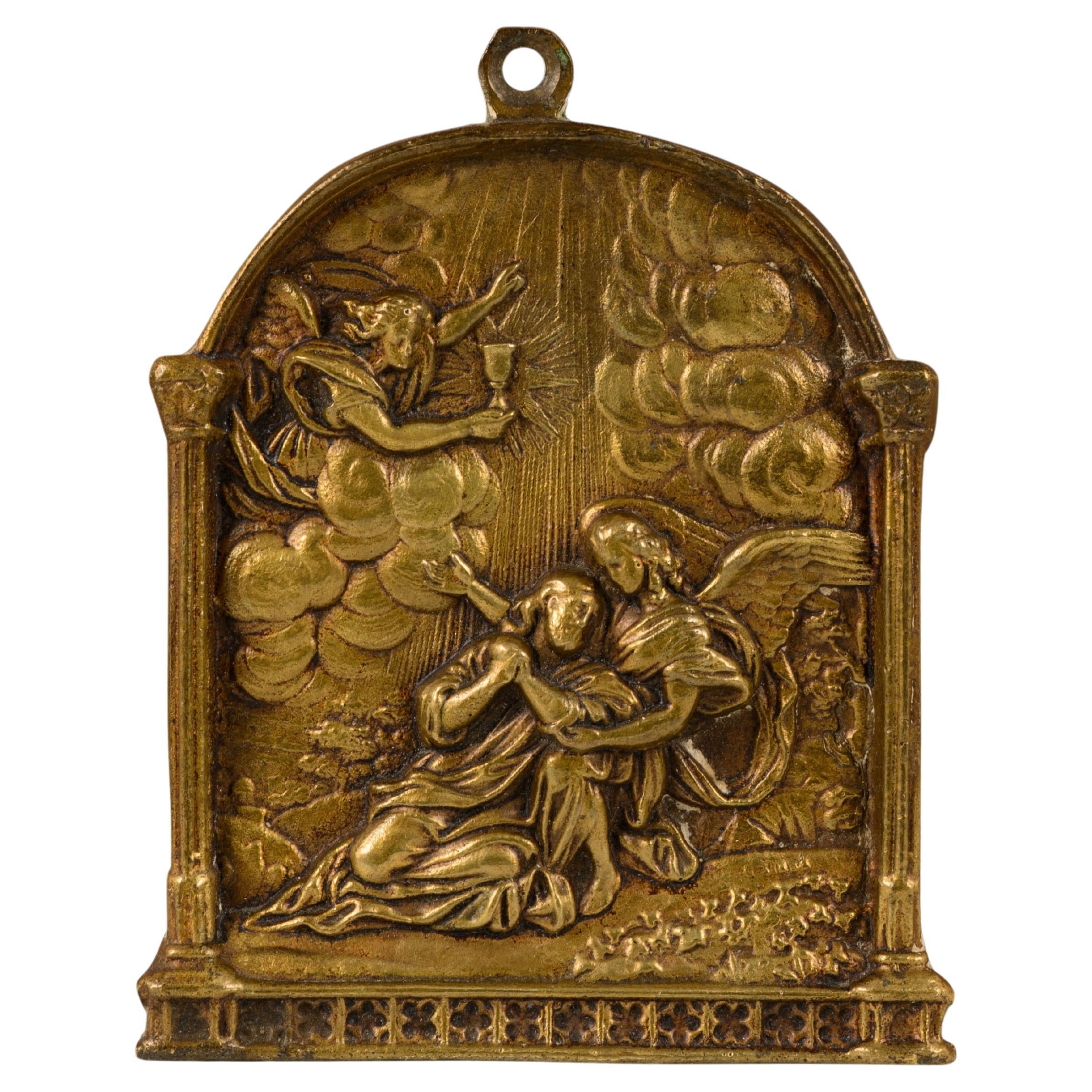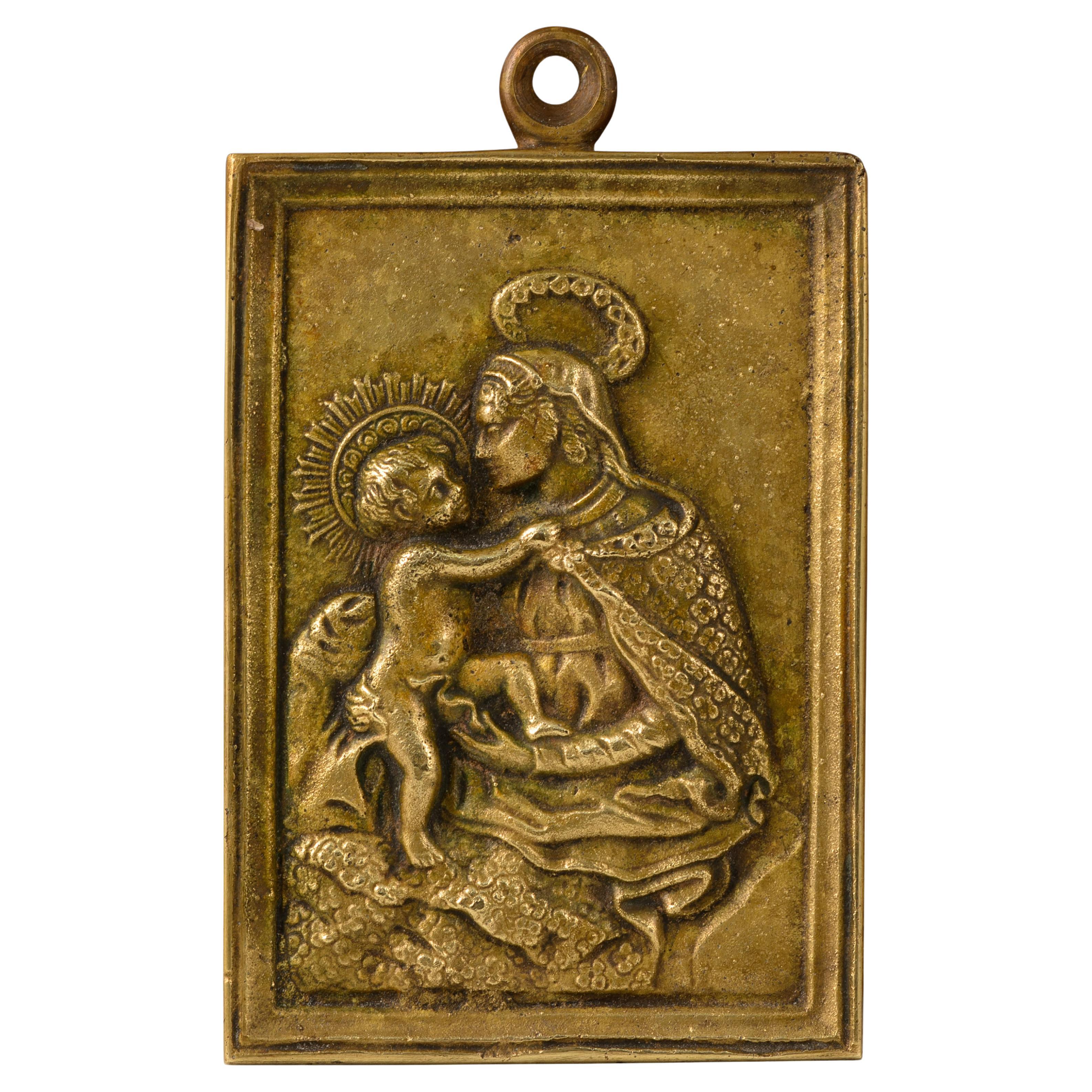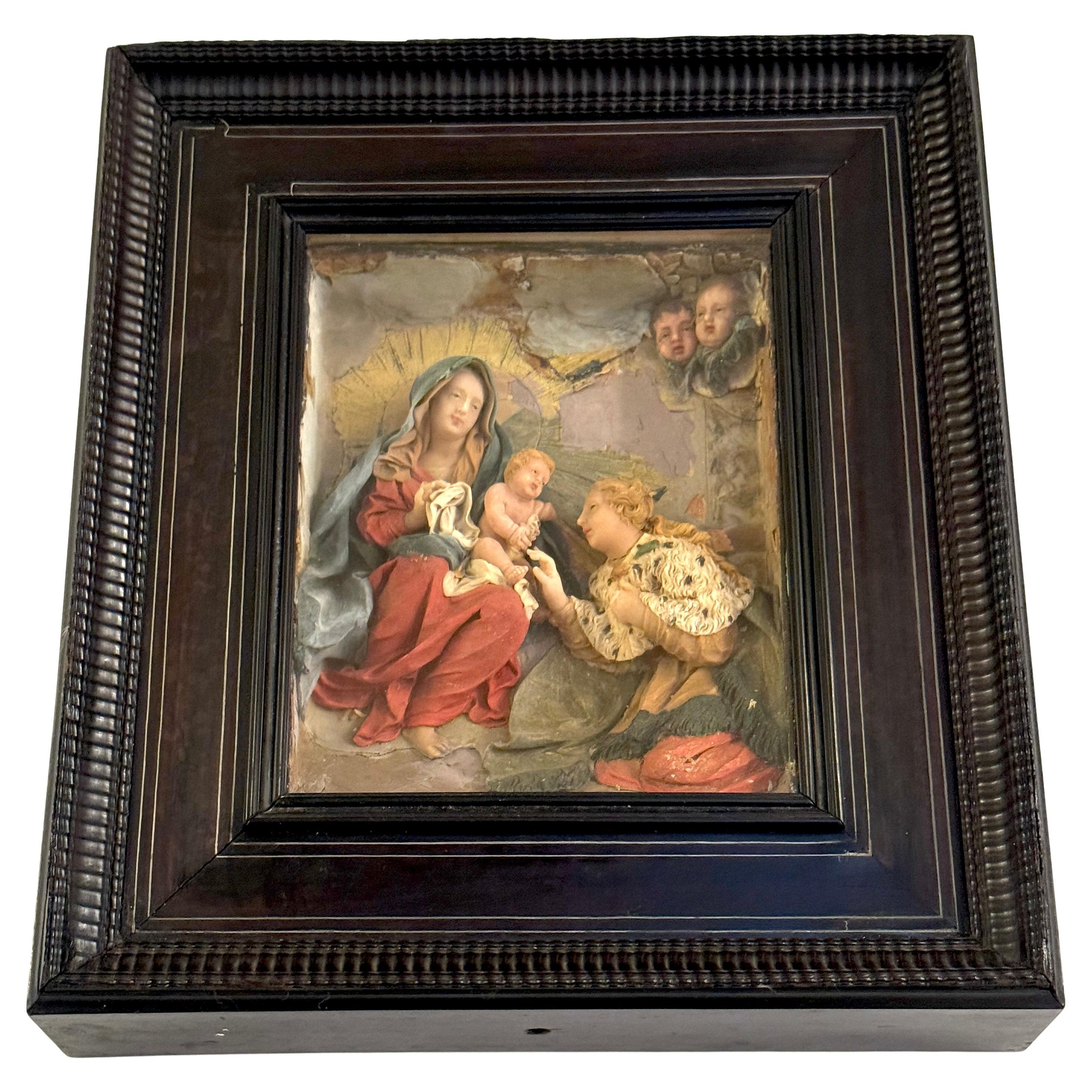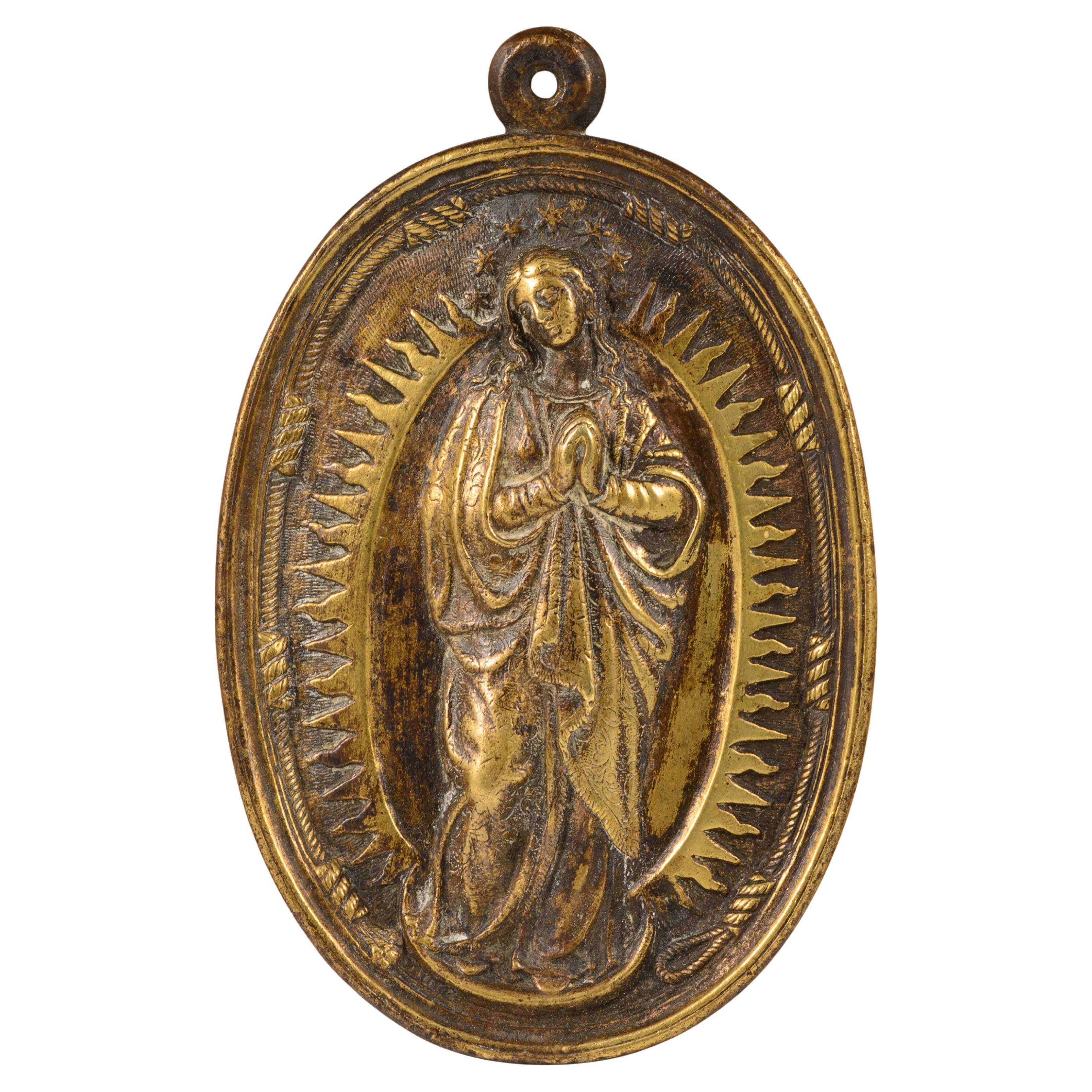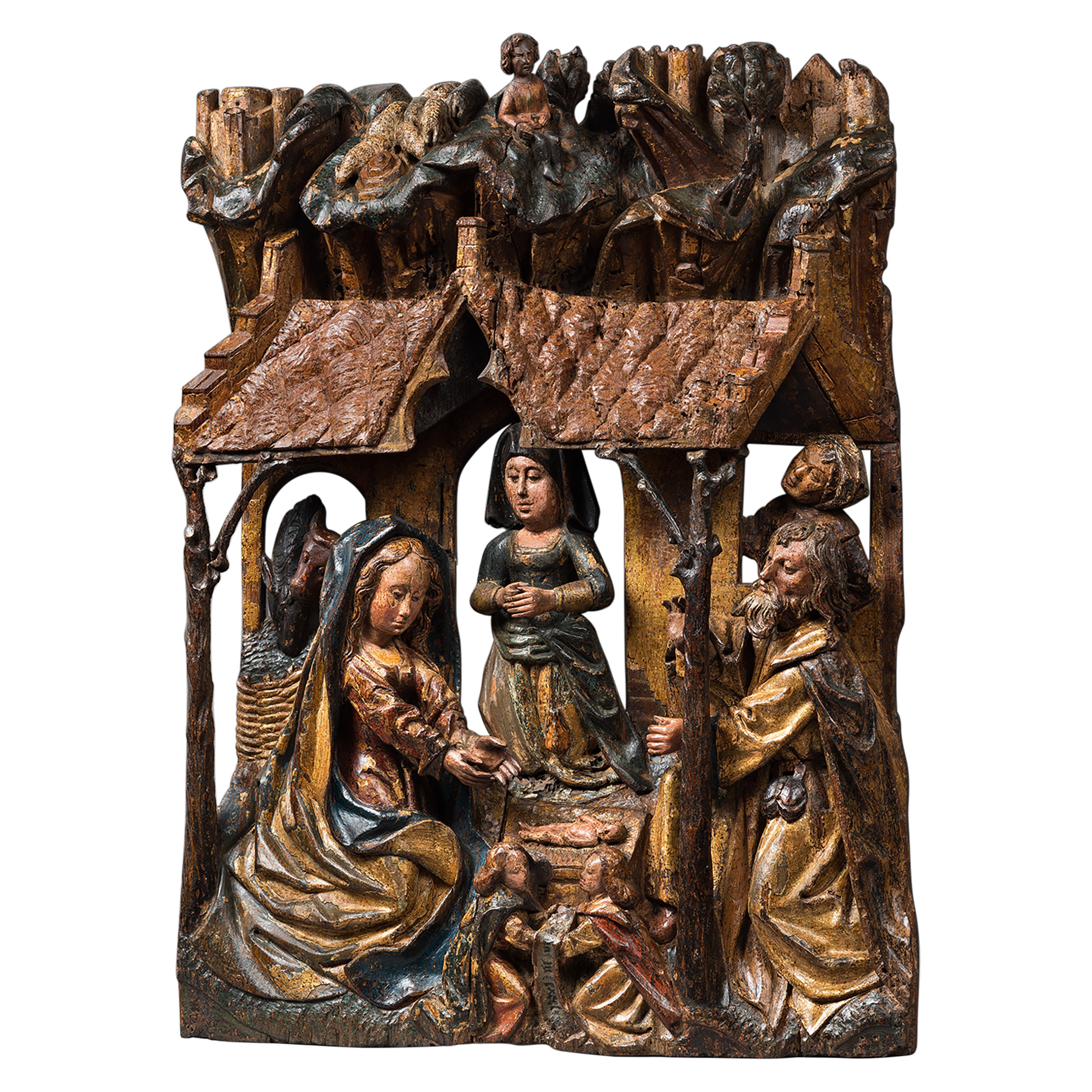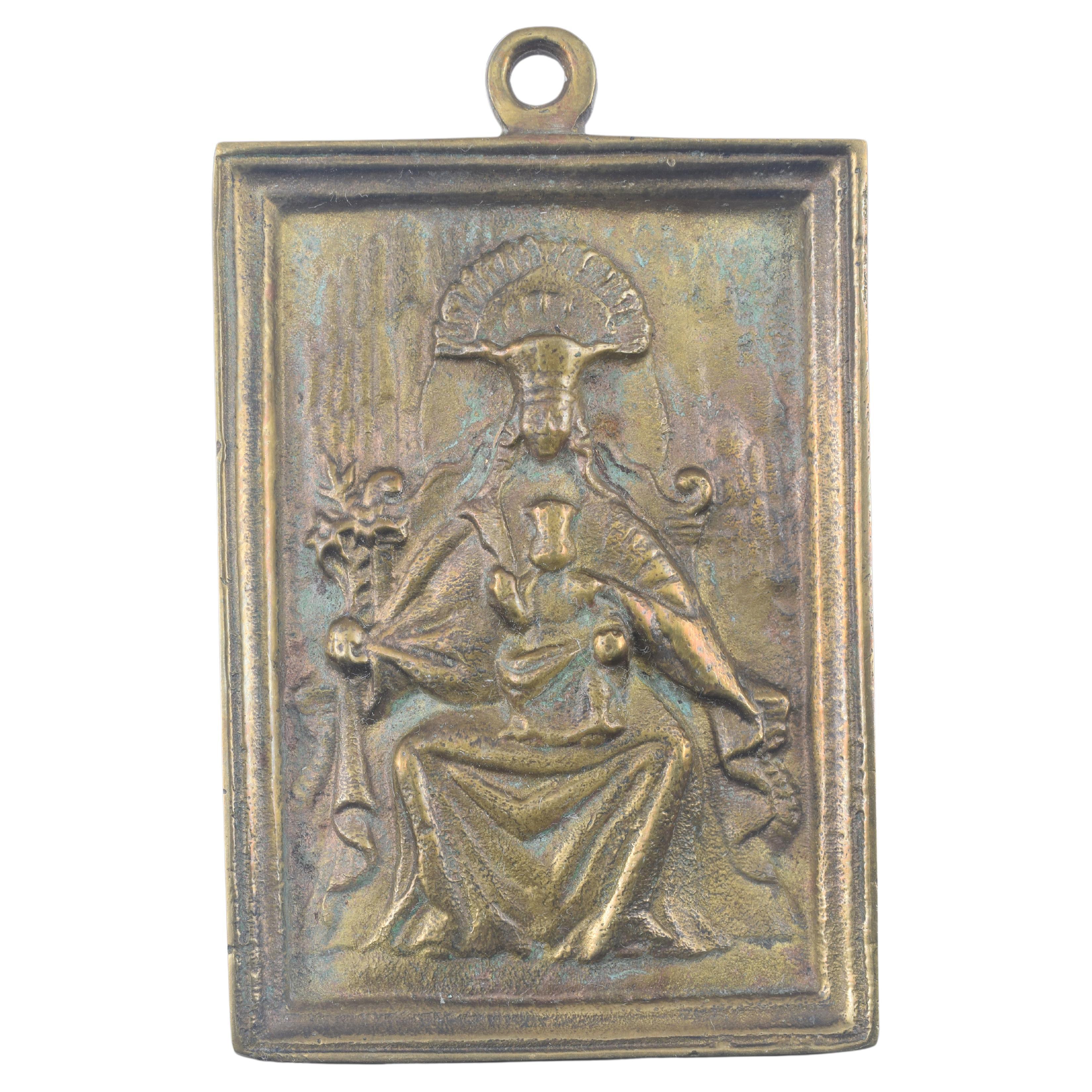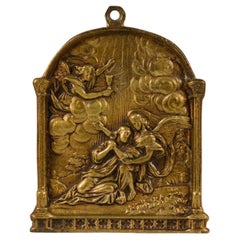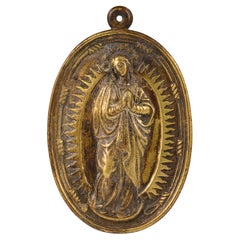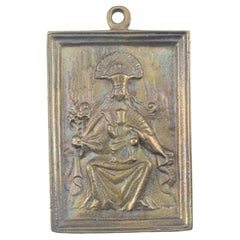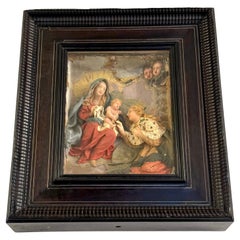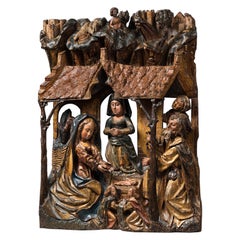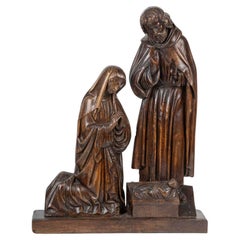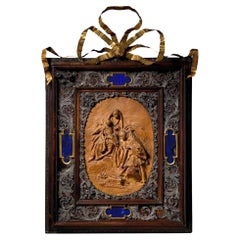Items Similar to Devotional plaque, Birth of Christ. Bronze. 19th century.
Want more images or videos?
Request additional images or videos from the seller
1 of 5
Devotional plaque, Birth of Christ. Bronze. 19th century.
$176.79
£133.16
€150
CA$243.81
A$273.90
CHF 143.12
MX$3,343.14
NOK 1,817.15
SEK 1,710.46
DKK 1,141.74
About the Item
Devotional plaque, Birth of Christ. Bronze. 19th century.
Devotional plaque made of bronze featuring a ring at the top, a curved shape at the top, a frame with architectural forms reminiscent of the Gothic, and a Christian figurative theme in relief on the front. It depicts the Birth of Christ with the Adoration of the Shepherds.
Weight: 226 grams. · Size: 9x0,5x11 cm
International Buyers – Please Note: for those articles that need Export Permits (those older than 100 years), the obtaining of the Permit will be processed without additional expenses (if you choose the seller sends it to you), but the period for the obtention of it may vary from 10 to 35 days.
- Dimensions:Height: 0.2 in (5 mm)Width: 3.55 in (9 cm)Depth: 4.34 in (11 cm)
- Style:Baroque (In the Style Of)
- Materials and Techniques:
- Place of Origin:
- Period:
- Date of Manufacture:17th-18th centuries
- Condition:Wear consistent with age and use. Minor fading.
- Seller Location:Madrid, ES
- Reference Number:Seller: ZF1416S1stDibs: LU2951345601052
About the Seller
4.9
Vetted Professional Seller
Every seller passes strict standards for authenticity and reliability
Established in 1985
1stDibs seller since 2017
347 sales on 1stDibs
Typical response time: 8 hours
- ShippingRetrieving quote...Shipping from: MADRID, Spain
- Return Policy
Authenticity Guarantee
In the unlikely event there’s an issue with an item’s authenticity, contact us within 1 year for a full refund. DetailsMoney-Back Guarantee
If your item is not as described, is damaged in transit, or does not arrive, contact us within 7 days for a full refund. Details24-Hour Cancellation
You have a 24-hour grace period in which to reconsider your purchase, with no questions asked.Vetted Professional Sellers
Our world-class sellers must adhere to strict standards for service and quality, maintaining the integrity of our listings.Price-Match Guarantee
If you find that a seller listed the same item for a lower price elsewhere, we’ll match it.Trusted Global Delivery
Our best-in-class carrier network provides specialized shipping options worldwide, including custom delivery.More From This Seller
View AllDevotional plaque, The Prayer in the Garden. Bronze. 19th century.
Located in Madrid, ES
Devotional plaque, The Prayer in the Garden. Bronze. 19th century.
Devotional plaque featuring a ring at the top for wall mounting and a religious figurative relief on the front fra...
Category
Antique 19th Century European Other Religious Items
Materials
Bronze
Devotional plaque, Virgin and Child. Bronze. Spanish School, 17th century.
Located in Madrid, ES
Devotional plaque, Virgin and Child. Bronze. Spanish School, 17th century.
Rectangular devotional plaque, made of bronze, featuring a ring at the top, a molded frame, and a relief ...
Category
Antique 17th Century Spanish Baroque Religious Items
Materials
Bronze
Devotional plaque, Immaculate Conception. Bronze. Spanish School, 17th century.
Located in Madrid, ES
Devotional plaque, Immaculate Conception. Bronze. Spanish School, 17th century.
Bronze devotional plaque with a washer at the top and an oval shape featuring a relief on the front....
Category
Antique 17th Century Spanish Baroque Religious Items
Materials
Bronze
Devotional plaque, Virgin of Montserrat. Bronze. Spanish school, 19th century.
Located in Madrid, ES
Devotional plaque, Virgin of Montserrat and the Mountain. Bronze. Spanish school, 19th century.
Devotional plate made of bronze, with a rectangular shape, which has a washer in its ...
Category
Antique 19th Century Spanish Neoclassical Revival Religious Items
Materials
Bronze
Pax or Pax Board, Bronze, Spain, 16th Century
Located in Madrid, ES
Paper holder bronze, 16th century.
Portapaz made of bronze with an "asymmetric" handle on the back, which presents a decoration in light relief framed in an architectural compositio...
Category
Antique 16th Century European Renaissance Religious Items
Materials
Bronze
Devotional plaque, Saint Anthony of Padua. Bronze. Spanish School, 17th century.
Located in Madrid, ES
Devotional plaque, Saint Anthony of Padua. Bronze. Spanish School, 17th century.
Oval-shaped devotional plaque made of bronze with a ring at the top, a molded frame with an interior...
Category
Antique 17th Century Spanish Baroque Religious Items
Materials
Bronze
You May Also Like
Baroque Wax Plaque of Adoration of the Magi, Italian School 18th C. or Older
Located in West Palm Beach, FL
Baroque Wax Plaque/Carving of Adoration of the Magi
Italian School 18th Century or Older
Pigmented Wax, Wood, Carved and Inlaid Ebony, Glass
A remarkable Baroque wax relief of The A...
Category
Antique 18th Century French Baroque Figurative Sculptures
Materials
Glass, Ebony, Wood
Late 15th Century Polychrome Wood Carving Depicting the Nativity
Located in Saint-Ouen, FR
While the birth of Christ is briefly told in the Gospel of Luke (2, 7) it is in the apocryphal texts that we find most of the elements and details that have then inspired artists. As of the 14th century and even more of the 15th century the subject of the Adoration of the Child replaces in Western art the scene of the Birth, much favoured in Byzantine art. Instead of being depicted lying with the new-born swathed in the manger, the Virgin is now kneeling, her hands joined in prayer in front of the naked child. This change was probably hastened by the popularity of the visions of Saint Bridget of Sweden to whom the Virgin allegedly appeared to show how she had given birth to Jesus (Visions, VII, chap. 21).
Sheltered by a thatch-roofed structure the Virgin is kneeling in front of the Child Jesus. She wears a magnificent red dress under a large gold cloak. Her curled blond hair is partially veiled. The newborn is lying on a straw mat. Joseph is depicted with a parted beard and stands opposite from the Virgin. He wears a tunic and a coat with a purse hanging from the belt. His costume reminds us of the long journey him and Mary have accomplished to reach Bethlehem.
Two other women are present. One is looking through the stable’s window to observe the Holy Family while another one kneels in prayer in front of the divine child. The rich costume of the lady might indicate she is a donator.
However they could also both represent the women who took part in the birth of Christ, Zelemi and Salome. Salome, incredulous did not believe in the virginal conception of Mary and she is represented far from the scene. The artist has depicted her with an expression of doubt on her face. Zelemi, on the contrary, is a believer. She is rewarded by a place of honour at the heart of the scene, close to Mary.
To the left the donkey and ox that have accompanied Mary and Joseph to Bethlehem observe quietly the scene.
On the foreground two angels hold a scroll reading an excerpt from the Gloria : “/Gloria/ in excelsis /Deo/.” One of the angels wears a blue cape while the other’s is red Those two colours are very significant as during Middle-Ages blue symbolises hope and red charity. Together they express the hope in redemption thanks to the advent of Christ and his sacrifice to come.
Above the main scene, up a cliff, a small shepherd lets his herd of sheep graze amidst the trees. He is framed by two walled cities.
This wood carving is the work of a very skilled and inventive artist. The piece bears witness to his exceptional talent. The realism of the scene is emphasised by the amount of details depicted. The refinement of the carving itself is highlighted by the well preserved polychromy.
This key moment of the New Testament is set in a contemporary context thanks to the clothes of the characters and the scenes of rural life. The universal dimension of the scene is intensified while allowing contemporary viewers to grasp its meaning more easily.
This care for details, the picturesque realism as well as the extraordinary rendition of the cloths suggest it was made by a Flemish artist during the late 15th century.
This relief can be compared with the panel of the Nativity from the Saint-Vaast altarpiece made by Jacques Daret between 1433 and 1435, today in Madrid’s Thyssen-Bronemisza Museum.
Literature
Louis Réau, Iconographie de l’Art chrétien...
Category
Antique 15th Century and Earlier Dutch Gothic Figurative Sculptures
Materials
Wood
Religious Sculpture Representing the Nativity, Carved Wood from the 16th Century
Located in Saint-Ouen, FR
Religious sculpture representing the nativity, carved wood from the 16th century.
Carved wood sculpture, walnut wood and oak wood base, sculpture representing the nativity, circa 16...
Category
Antique 16th Century French Neoclassical Figurative Sculptures
Materials
Oak, Walnut
Terracotta Relief of the Virgin and Child Appearing to St. Philip Neri
Located in London, by appointment only
A mid-18th-century Italian terracotta relief of the Virgin & Child appearing to St Philip Neri In a silver filigree, gilt-bronze and gilt-copper-mounted, lapis lazuli and wood frame.
Known as the ‘Apostle of Rome’ due to his labours amongst the sick and poor of the city, Philip Neri (1515-1595) became an influential figure of the Counter-Reformation. Many miracles were attributed to him, and he was beatified by Paul V in 1615. His popularity and place in the folklore of Rome created a demand for his depiction within the church.
For example, Carlo Maratta’s painting for San Giovanni dei Fiorentini, the preliminary study for which bears relation to the present composition (Royal Collection, inv. 905553). The fresh and freely modeled handling of the present relief is in the tradition of Giovanni Antonio Mazzuoli’s (1644-1706) small-scale modelli for altarpieces (C. Sisi and G. Gentilini, La Scultura : bozzetti in terracotta, piccoli marmi e altre sculture dal XIV al XX secolo, Florence, 1989, nos. 92-95).
Additional information:
Origin: Italy
Period: Circa 1750, 18th Century
Style: Religious, The Virgin and...
Category
Antique 18th Century Italian Baroque Decorative Art
Materials
Terracotta
1950s Spanish Brass Framed Repoussé Scene of Christ Giving Communion
Located in Marbella, ES
Vintage 1950s Spanish framed repoussé hammered low-relief scene of Jesus Christ giving communion.
Category
Mid-20th Century Spanish Decorative Art
Materials
Brass
Virgin Mary and Baby Jesus Ceramic Sculpture/Relief Frame
Located in Guaynabo, PR
This a sculpture/relief of the Virgin Mary holding very tenderly a Baby Jesus who fell asleep. It is attached to an almost square wood frame. The sculpture stand over an oval wood base. Her eyes are blue and looking up with a serene gaze ( like praying ). The Virgin Mary is wearing a pine green robe...
Category
Mid-20th Century Unknown Figurative Sculptures
Materials
Ceramic
$1,800 Sale Price
20% Off
More Ways To Browse
The Shepherd
Spanish Frame 17th Century
Antique Spanish Rings
Christ Ring
17th Century Gold Ring
17th Century Plaque
Antique Gothic Rings
Adoration Of The Shepherds
Adoration Shepherds
Antique Wooden Crucifix
Ivory Christ
Maltese Cross Furniture
Antique Spanish Sword
Antique Spanish Swords
Christ Wood Carving
Bible Table
Church Brass Cross
Mary And Baby Jesus
